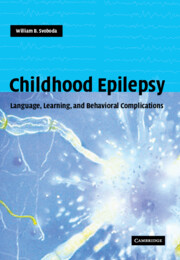Book contents
- Frontmatter
- Contents
- Preface
- Glossary
- 1 Looking ahead
- Part I Speech and language problems
- Part II Learning problems
- 12 Learning challenges
- 13 The development of learning
- 14 Learning difficulties
- 15 Learning problems with seizure types
- 16 Modifying factors
- 17 Transient cognitive impairments of epilepsy
- 18 Attention and alertness
- 19 Memory
- 20 Executive functioning
- 21 Academics
- 22 Antiepileptic medication effects
- 23 Effects of other therapies
- 24 Diagnosis
- 25 Gaining help
- 26 Frustrations of learning problems
- Part III Behavior problems
- Index
- References
18 - Attention and alertness
from Part II - Learning problems
Published online by Cambridge University Press: 26 October 2009
- Frontmatter
- Contents
- Preface
- Glossary
- 1 Looking ahead
- Part I Speech and language problems
- Part II Learning problems
- 12 Learning challenges
- 13 The development of learning
- 14 Learning difficulties
- 15 Learning problems with seizure types
- 16 Modifying factors
- 17 Transient cognitive impairments of epilepsy
- 18 Attention and alertness
- 19 Memory
- 20 Executive functioning
- 21 Academics
- 22 Antiepileptic medication effects
- 23 Effects of other therapies
- 24 Diagnosis
- 25 Gaining help
- 26 Frustrations of learning problems
- Part III Behavior problems
- Index
- References
Summary
Learning is dependent on three closely interrelated brain foundations: attention, memory system, and executive functioning. If one of these fundamentals fails, learning often falters. Up to 60% of children seen in an epilepsy clinic may have attention deficits (Williams et al., 1992).
Attention
Alertness may be impaired in epilepsy (Stores, 1987), unrelated to the seizure type or EEG abnormality (Bruhn-Parsons & Parsons, 1977; Aldenkamp et al., 1993). Approaches to tasks are similar but the search time is prolonged. More specific deficits may modify this, according to the seizure type, frequency, type of EEG abnormality, and onset age (Aldenkamp et al., 1990). Impaired attention may contribute to decreased academic performance regardless of the seizure type, gender, and duration of the epilepsy (Williams et al., 2000).
What is attention?
The most important question is what is meant by an attention problem? Attention, concentration, alertness, arousal, and other related terms signify different abilities. Attention refers to a general state of arousal, selection, concentration, vigilance, search time, and the triad of alertness, selectivity, and processing (Stores et al., 1978).
Attention can refer to both divided attention and focused attention. A divided attention deficit means that the individual cannot handle multiple inputs. A focused attention deficit means that the child incorporates irrelevant stimuli into the thought process even when the object of attention is known.
Attention can also refer to both immediate attention and sustained attention. Immediate attention is the act of being attracted to a stimulus.
- Type
- Chapter
- Information
- Childhood EpilepsyLanguage, Learning and Behavioural Complications, pp. 268 - 288Publisher: Cambridge University PressPrint publication year: 2004



